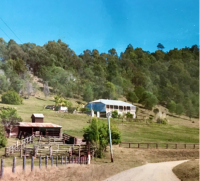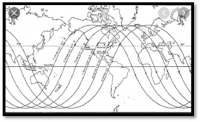by Roy Curry
“I see it…a tiny glowing blob moving north… That’s Sputnik?” I was a bit disappointed that the Soviet Union’s spy in the sky was just a puny small light in the clear night sky of October 1957 as my family watched from near the farmhouse. Moments later when I looked again. Sputnik was gone. “How fast was it moving?” I asked. That simple question launched me to many adventures into the world of physics, astronomy, and cosmology. I was not at all concerned about any impending takeover of the world by a Soviet Empire.

“You might be able to work out how fast Sputnik moves,” my mother suggested, “because it goes in a big circle 500 miles above the earth every hour and a half.” She remembered that you used the number 22 over 7 to find the distance around a circle. From my small general encyclopedia, I found that 22/7 was close to the value of a number called pi. “Multiply pi by the diameter and you can find the circumference of a circle.” I repeated to myself like a secret mantra, following the formula in the encyclopedia. The earth’s diameter was about 8000 miles so with some longhand multiplication I worked out that Sputnik travelled 27000 miles every hour and a half. That’s 17000mph, after a bit of longer division.
There was no TV news with detailed analyses of current events, no internet and other easy way to find out if this speed was correct. Days later, someone on the radio mentioned that the United States could not shoot Sputnik down because it was travelling at 18,000 mph. There was my answer, I was elated.
With this new confidence in my math skills, the moon was my next target for investigations. It was my job after helping to milk the cows in the evening to feed young calves that had been weaned from their mothers. I sat in the dark away from the dairy holding a tin bucket filled with milk while the calves slowly drank. With nothing else to do I watched the full moon rise and move across the sky between the silhouettes of two tall trees in a nearby paddock. It seemed straightforward to find the speed of the moon across the sky. I looked up the distance from the earth to the moon in my trusty little encyclopedia and I used pi again to find the distance the moon would move as it crossed the night sky near me in about 10 hours. The speed I found was amazing, 70,000 mph. I was in my own little heaven.
So, while the US and the West had their Sputnik crises as the new satellite circled and bleeped above our heads, I had my own very different awakening to a new reality.
But as the glow of the full moon waned on successive nights later in that October, so did my confidence. The shape of the moon’s image that I now saw in the evening changed because the moon took a month to go around the earth, not 10 hours. Something was really wrong with my sums.
If the moon took a month to go around the earth, it must be going much slower. I did the sums, about 2000 mph. Too slow for me to see it move between the nearby trees. So, as I sat feeding the calves, I slowly realized that then I saw the moon moving against the trees, it must be because I was moving, not the moon. How fast was I moving? I expected it had to be pretty slow because I could not feel any motion. I did more sums. When I sat on my little patch on the surface of the earth, and the earth spun on its axis every 24 hours, my sums told me I was doing about 1000 mph. Now this I found really hard to believe, but I really wanted it to be true. But Stirling Moss, the champion race car driver, had just set a land speed record of 250 mph, and I was supposed to be moving four time faster than that.
My parents could not tell me why I did not feel as if I was doing 1000 mph. I really wanted to find a way to experience that! “We probably just get used to it.” was their best suggestion. In a way they were right. I was learning, long l before I ever meet Newton and his laws, that we only experience our speed when forces act to change the speed. I think of this every time I am sitting in a quiet plane.

So, while the US and the West had their Sputnik crises as the new satellite circled and bleeped above our heads, I had my own very different awakening to a new reality. I did not know it then but when I tried to calculate the speed of moon, I had made the same mistake that the astronomers before Copernicus had made. What we see as the movement of heavenly bodies across the sky does not mean we are the center of the universe, only the man-made Sputnik was close enough and fast enough for errors in calculating its speed to be small. But my sputnik adventure was the beginning of a long journey through the mysteries of the skies above me. I learned that the light that from the stars of the constellation Southern Cross left those stars before my grandparents were born. The youngest star was 88 light years away. I was not only speeding along through space, but also seeing back in time.
I can no longer even begin to do the math needed to understand the wonders of today’s cosmology: the expanding universe, the cosmic background radiation, the spectral red shifts of the light, but when camping in the Sierras or sitting outside in a hot tub at Sea Ranch I re-connect with the many successors of Sputnik 1. I look for their tiny light knowing each sighting will take me back to the time when my own universe became a whole lot bigger.
